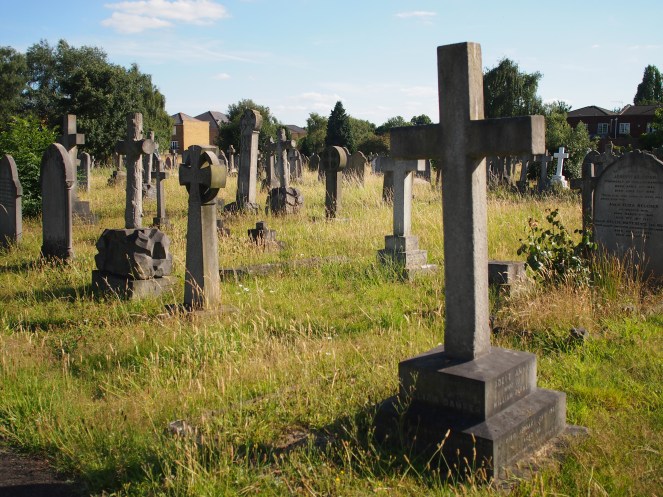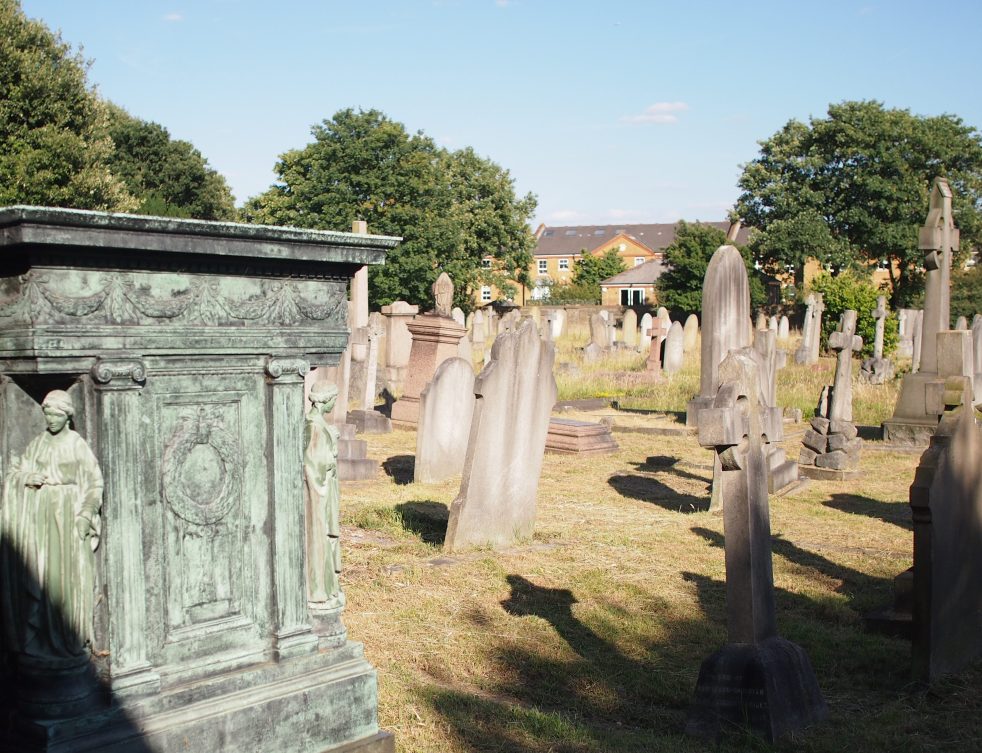Chiswick Old Burial Ground is a large extension to the old churchyard at St Nicholas, Chiswick, close to the River Thames in west London. The Georgian graves clustered closest to the church (including the grand tomb of the artist William Hogarth) give way to Victorian and more modest headstones, filling a site that’s just under 7 acres in size. Unlike some of London’s larger Victorian cemeteries, most of the memorials here are fairly modest in scale and ornamentation, made from stone or occasionally marble. But one incongrous memorial catches the eye, despite being tucked away near the cemetery’s northern boundary wall: a striking copper tomb turned green by the passing of the years, which marks the burial place of two artists.

On 12th May 1896, on what would have been her 39th birthday, Beatrice Whistler was laid to rest at Chiswick Old Burial Ground. She had been ill with cancer, and with her husband, James McNeill Whistler, had returned to her native London for treatment, leaving behind the home in Paris where they had lived and worked since 1892.

James McNeill Whistler, Beatrice’s widower, is a well-known artist: many books have been written about him, and his works hang in prestigious galleries. We will look more at his life and work in a moment, but first of all it seems right to examine the life and career of his wife, a talented woman who was an artist and designer in her own right, and whose name often goes unmentioned when their beautiful tomb is pictured in guidebooks and articles about London’s graveyards.

Beatrice came from an artistic family – her father was the Scottish sculptor John Birnie Philip, who often worked with the celebrated Gothic Revival architect Sir George Gilbert Scott. John Birnie Philip’s work can be seen in some of the friezes and statues that adorn the Albert Memorial in Kensington, and on the exterior of the Foreign and Commonwealth Office on Whitehall.
John and his wife Frances Black had ten children – Beatrice, born in 1857, was their eldest daughter. The family lived in Chelsea, famously a home to many artists and creatives in the Victorian period. Beatrice studied art in her father’s studio, and later became a designer in the office of the architect-designer Edward Godwin, a friend of her father’s. Edward Godwin was an important figure in architecture and design in the mid-Victorian period, incorporating Japanese art and design into some of his work, and later acting as an influencer of the Aesthetic and Arts and Crafts movements. As well as designing buildings, Godwin also created designs for furniture and wall coverings, many of which were then sold at Liberty of London. Beatrice, working as one of his designers, may well have been involved in the creation of many of these designs, and certainly throughout her career she produced many images – such as these drawings of finches – that were then used for decorative furniture panels, tiles and wallpaper designs. Many of Beatrice’s drawings and designs feature birds; she kept pet birds at home and enjoyed observing and drawing them.


Beatrice’s father John died in 1875, and the following year, Beatrice married Edward Godwin. The couple had one son, Edward, born in 1876. After her marriage, Beatrice continued her job as a designer, and many of her designs were sold to manufacturers for commercial production. In 1877, James McNeill Whistler – a friend of the Godwins, and Beatrice’s future second husband – commissioned Edward Godwin to design him a grand new house on Tite Street in Chelsea. Beatrice designed the decorative brick panels for the house’s exterior, and also designed wallpapers and panels to decorate the house and its furniture. Sadly much of her work on the White House, as it was known, has been lost – the house was extensively remodelled after Whistler was forced to sell it, and the house itself was demolished in 1968.

The Godwins’ connection with James Whistler also helped to further advance Beatrice’s artistic career. She sat as a model for Whistler on a number of occasions, and also became one of his pupils, producing her own oil paintings. She signed her work with the initials BP or BG, and exhibited her work under the name Rix Birnie, as she did not wish to be identified as a female or amateur artist, perhaps fearing that her work might have been less well-received if her gender were known. Most of her surviving paintings depict women, often members of her family or close friends, in informal, domestic situations. Margaret MacDonald, author of the biography of Beatrice in the Oxford Dictionary of National Biography, wrote that “her drawings of women are vivid and sympathetic, her paintings intimate, with soft, subtle colour harmonies.”

Edward Godwin had a number of extramarital affairs, and Beatrice separated from him in 1885. Godwin died a year later, and in August 1888 Beatrice married James Whistler, who had by that time separated from his long-term mistress Maud Franklin. Their wedding was a low-key event, not publicised in advance due to worries that Maud, who was aggrieved by the breakdown of her relationship with Whistler, might disrupt the ceremony. By all accounts Beatrice and Whistler had a happy marriage – in a letter to Beatrice in 1892, Whistler wrote: “I look around and see no others as happy as we two are in each other.” When they were first married they lived in Chelsea, first in a house on Tite Street and later on Cheyne Walk. In 1892 they relocated to Paris, setting up home at 110 rue de Bac. It was Beatrice who oversaw the design and decoration of their Parisian home, and the top floor of the house was set aside as her studio space.

James McNeill Whistler was born in Lowell, Massachussetts in 1834, to parents George Washington Whistler, a railroad engineer, and Anna McNeill. Whistler showed artistic promise from a young age, but initially pursued a military career. However, after a failed stint at the West Point Military Academy he moved to Europe in 1855, first of all moving to Paris, and later to London. Although not as well known today as his contemporary John Singer Sergeant, he is regarded as an important 19th Century artist, associated with the Aesthetic Movement.

Whistler produced hundreds of etchings over his lifetime, but it is for his paintings that he is most famous. One of his most famous works is Arrangement in Grey and Black No. 1 (popularly known as ‘Whistler’s Mother’), a portrait of his mother Anna which was not well-received when it was first exhibited, but was later much talked-about and praised, even ending up being featured on an American postal stamp in 1934.

Whistler was involved in a ruinous legal case with John Ruskin in 1879, suing Ruskin for libel after Ruskin’s criticism of his work. Losing this case caused Whistler to go bankrupt – his property (including the house on Tite Street that Godwin and Beatrice had designed for him) and works had to be sold off to pay his debts. The Whistlers’ move to Paris in 1892 was also prompted by poor reviews of Whistler’s work – his solo exhibitions the early 1890s had been coolly received, and after these setbacks Whistler declared himself to have had enough of London.

The move to Paris proved to be fruitful for both of the Whistlers, with James’ career taking off again and Beatrice continuing her own artistic work. They mixed with many well-known artists of the day, including Claude Monet. It was only Beatrice’s diagnosis with cancer that took the couple back to London in 1894 – had she not become ill, they may well have remained in Paris for many more years. Whistler’s lithograph The Siesta depicts Beatrice during her final illness.

After Beatrice’s early death, Whistler was said to be devastated – one biographer commented that “his world was in ruins.” He died seven years after his wife, in 1903. Beatrice’s younger sister Rosalind, who had worked as a secretary for Whistler and had from time to time sat as a model for his paintings, was named the executor of Whistler’s will. It was Rosalind who bequeathed a large collection of both Whistler’s and Beatrice’s work to the University of Glasgow, where they still remain and where an exhibition of Beatrice’s work was held in 1997. Many works by the Whistlers have been digitised by the university and can be found here.
The copper tomb that marks the Whistlers’ final resting place in Chiswick would not be there had Whistler got his way. After Beatrice’s death, the grave was covered with a trellis that had roses growing on it, and Whistler himself apparently wished there to be no marker on the grave other than entwined roses. However, a few years after Whistler’s death, Beatrice’s son with Edward Godwin, also called Edward, designed a tomb for the couple.


The copper coating of the tomb has turned green over time – this may have been the intention of the designer. It has classical-style columns and is adorned with swags and floral patterns, the latter perhaps reflecting some of the artistic work done by the people it commemorates. The inscription beneath James and Beatrice’s names (“The place where I also at last hope to be hidden / for in no other would I be“) is taken from a November 1897 letter from Whistler, who had returned to Paris, to his friend Ethel Whibley, who had recently visited Beatrice’s grave in Chiswick:
Don’t let anything tomorrow come between you and the only place I can care for in all that terrible land
The place where I also, such is the wonderful sarcasm of fate, at last hope to be hidden
For in no other would I be.


The beautiful figures which adorn each corner of the Whistler tomb are sadly not the originals that were sculpted by Edward. These were stolen, and in 1993 a campaign was launched to raise money to fund the creation of replicas so that the tomb could be restored to its former glory. Today, the tomb is a little cobwebby, but is in a well-kept corner of the cemetery. A pot of pink flowers had been laid at the grave, possibly by a family member or well-wisher. Discovering this grave led me down a fascinating rabbit hole: it was wonderful to learn about Beatrice’s life, career, and artwork in the overwhelmingly male art world of the late nineteenth century, and I hope that by telling her story here that this wonderful tomb’s second, overlooked occupant will find a little limelight once again.


References and further reading
Margaret F MacDonald – Whistler, Beatrice (1857-1896), Oxford Dictionary of National Biography [requires login]
Beatrix Whistler, Art UK
Whistler Online Catalogue, Hunterian Art Gallery, University of Glasgow
“James Abbott McNeill Whistler.” Dictionary of American Biography, Charles Scribner’s Sons, 1936 (link)
Weinberg, H. Barbara. “James McNeill Whistler (1834–1903).” In Heilbrunn Timeline of Art History. New York: The Metropolitan Museum of Art, April 2010
McPhee, Constance C. “James McNeill Whistler (1834–1903) as Etcher.” In Heilbrunn Timeline of Art History. New York: The Metropolitan Museum of Art, April 2015
St Nicholas’ Churchyard and Chiswick Old Cemetery, London Gardens Online
Appeals: Old Chiswick Protection Society, The Independent, 27th November 1993


It looks like the happier of the graveyards . How are you? Bruce
LikeLiked by 1 person
Reblogged this on Cibi Quilters.
LikeLike
Reblogged this on thestreetnames.
LikeLike
A great article I had no idea that the Whistlers were buried in the UK, let alone London. A lovely tomb as well.
LikeLike
Reblogged this on shadows fly away and commented:
Whistler has always been one of my favourite artists and I loved this article on his and his wife’s final burial place.
LikeLike
Absolutely fascinating, thank you.
LikeLike